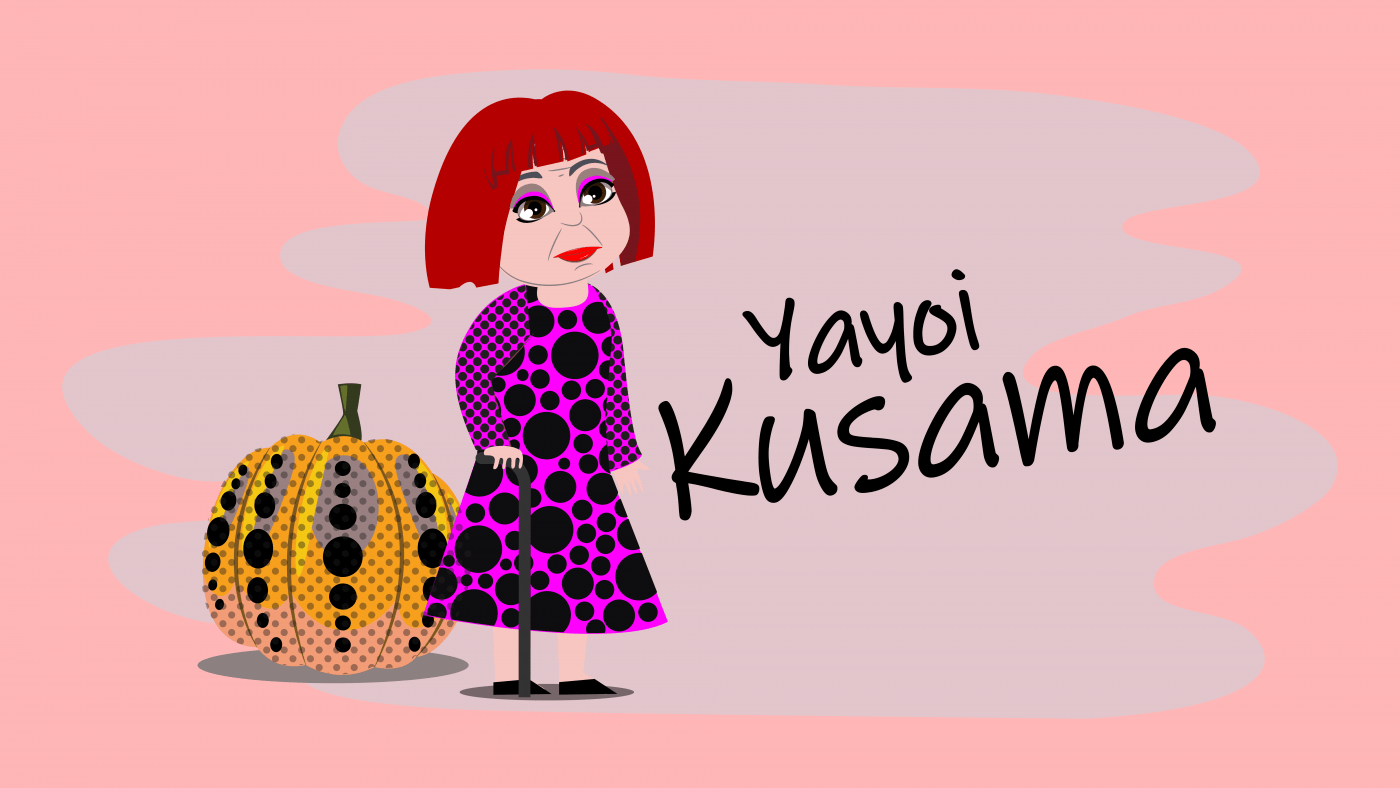No products in the basket.
Art History
Who is artist Yayoi Kusama? Have a look at her breathtaking artworks.
Contemporary Art History
Hi I’m artist Lillian Gray and I have someone you need to meet Japanese artist Yayoi Kusama. Yayoi Kusama is absolutely dotty about dots, she is sometimes called the princess of polka dots. She makes all kinds of art such as sculptures, paintings, installation, clothing design and even performances and they are all covered in dots.
She is a Japanese contemporary artist and one of the most important living artists today. People queue for hours and hours to only see a glimpse of her work. At her one exhibition you had to queue for two hours only to spend 30 seconds in a Kusama infinity room. She is celebrated all around the world and has exhibited internationally. Now what if I told you this art superstar lives in a mental health hospital and she has been there for the last four decades that’s over 40 years.
So why does she live in a hospital and what does she suffer from – depression? – anxiety? How did she become so famous? And what’s the story behind all these dots? And why is everybody so obsessed with it? Well, come with me and let me tell you about this amazing artist Yayoi Kusama!
The life of artist Yayoi Kusama

Born into a wealthy conservative family
Kusama was born in 1929 in Japan, she was born into a wealthy family of merchants who managed extensive plant nurseries and a seed farm. They grew a variety of flowers such as peonies and zinnias to sell all over Japan. From a young age Kusama was drawn to art and an avid drawer, she would carry her sketchbook with her and sometimes sit amongst the flowers to draw them, one day while doing so the flowers started crowding in on her, almost suffocating her and then they started speaking to her it was a terrifying experience that left Kusama trembling with fear.
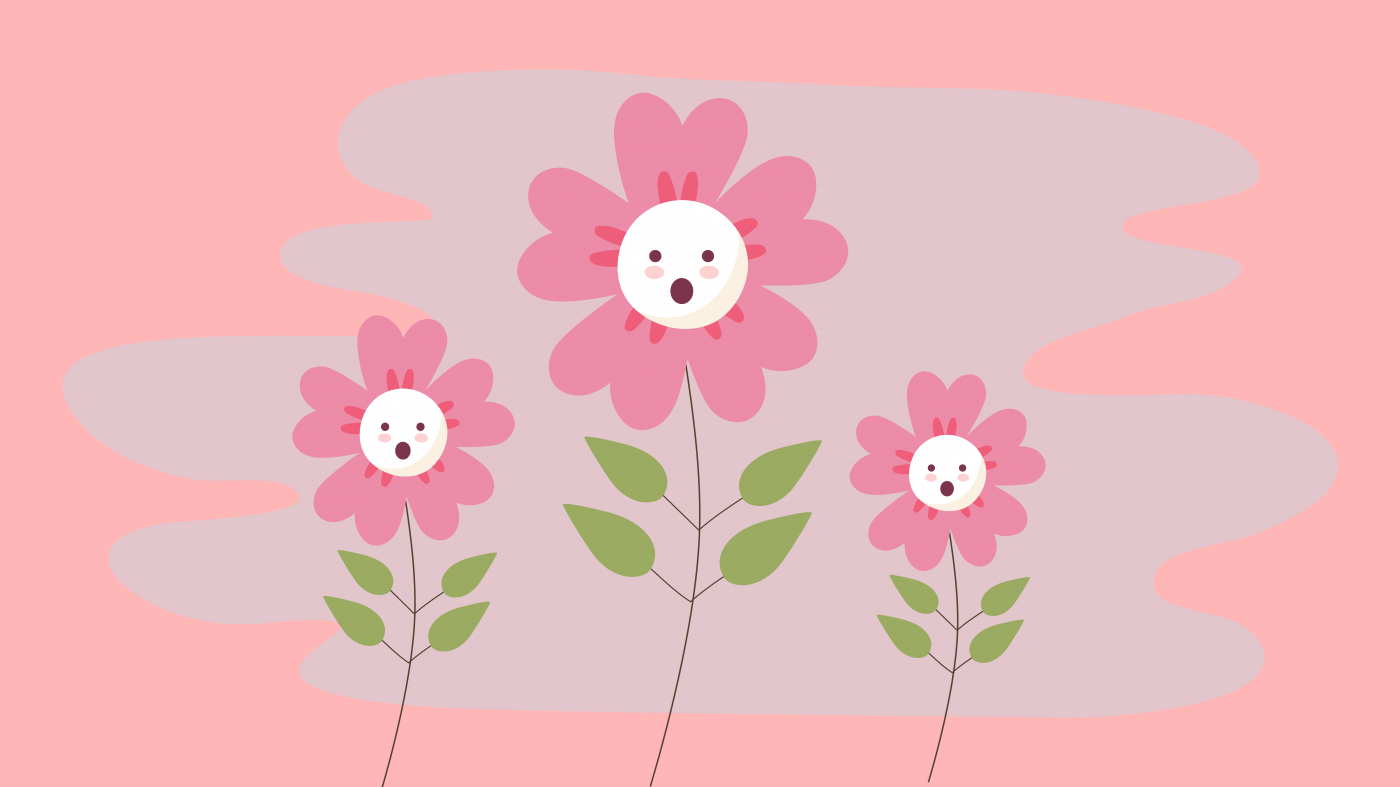
“I had thought that only humans could speak so I was so surprised that violets were using words I was so terrified my legs began shaking”
Yayoi Kusama
A troubled childhood filled with hallucinations and abuse
This was the first of a series of disturbing hallucinations that haunted Kusama’s childhood, it could be said that these hallucinations were due to Kusama’s unhappy childhood – Kusama grew up in a deeply unhappy family her father was a womanizer that often cheated on her mother, her mother was so jealous of all her father’s girlfriends she would often send little Kusama to spy on her father’s affairs.
Kusama would run back to her mom telling her what she had seen and her mother would lose it. She would take out all her anger and rage on little Kusama – beating her. This created a huge contempt in Kusama for romantic relationships and especially towards men, she started hating love between couples and she also really became disgusted in the male body.

Kusama’s mother was also very strict she wanted her daughters to follow the traditional Japanese way of living she wanted them to marry wealthy men and be housewives, her mother also did not support her drawing and painting.
She would often take her art away from her and try everything to stop her from drawing when she saw Kusama creating and wasting her time with art she would attack her ripping up her canvases and destroying it and she also threw away all of Kusama’s art supplies – what a horrible mother – but Kusama kept on drawing.
You see, Kusama’s art was her way to escape from her family, escape from her own mind, her anxiety, her depression and her hallucinations. She used her art to make sense of the world around her and all the trauma she was experiencing.
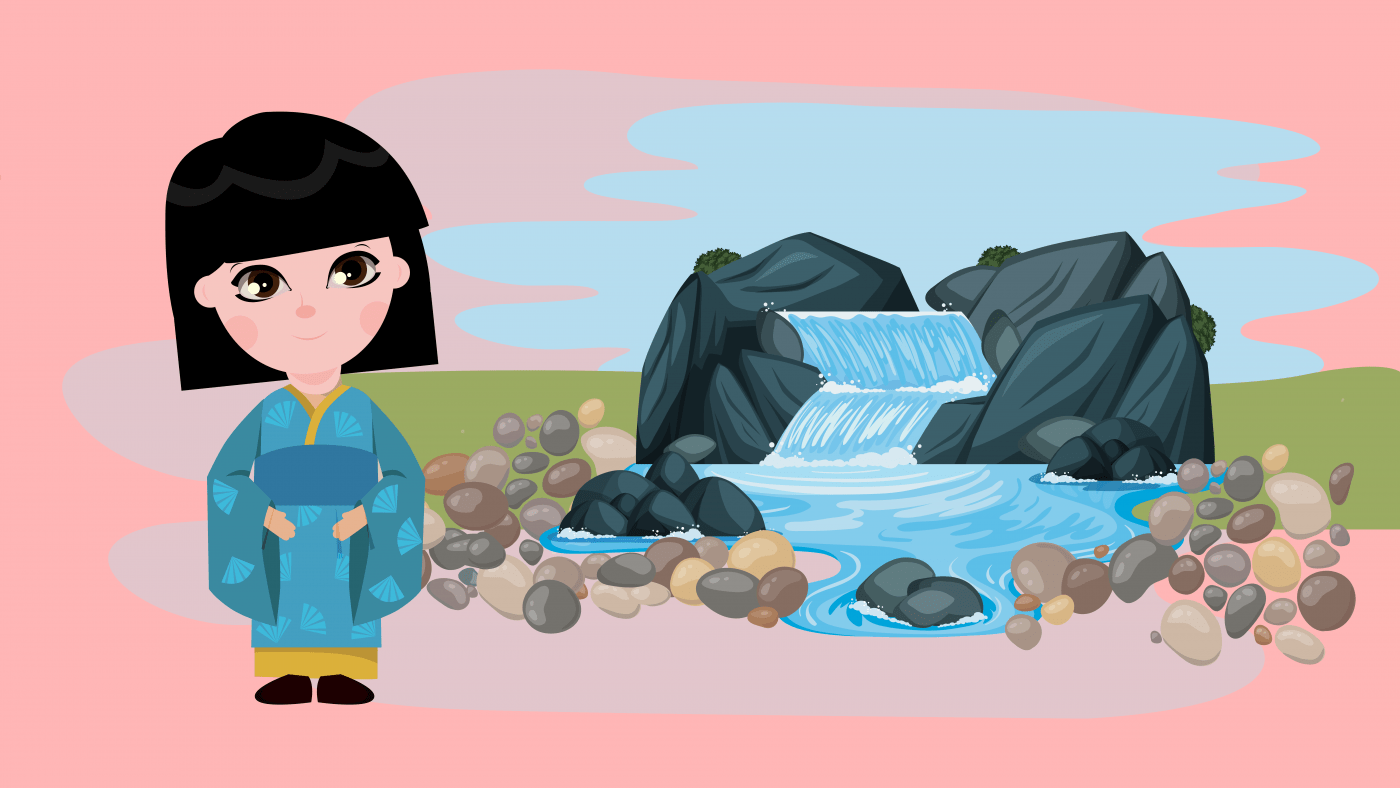
Becoming dotty about dots
One day she was absolutely fascinated by the smooth white stones covering the riverbed near her home she saw them as dots covering the earth and she ran home to draw it in her sketchbook. Recording these hallucinations helped her to ease the shock and fear of these episodes, this helped her to develop some of her trademark ideas and patterns early on. It captured her fascination with dots as well as establishing a pumpkin as one of her key motifs, she started drawing pumpkins when she was very little.
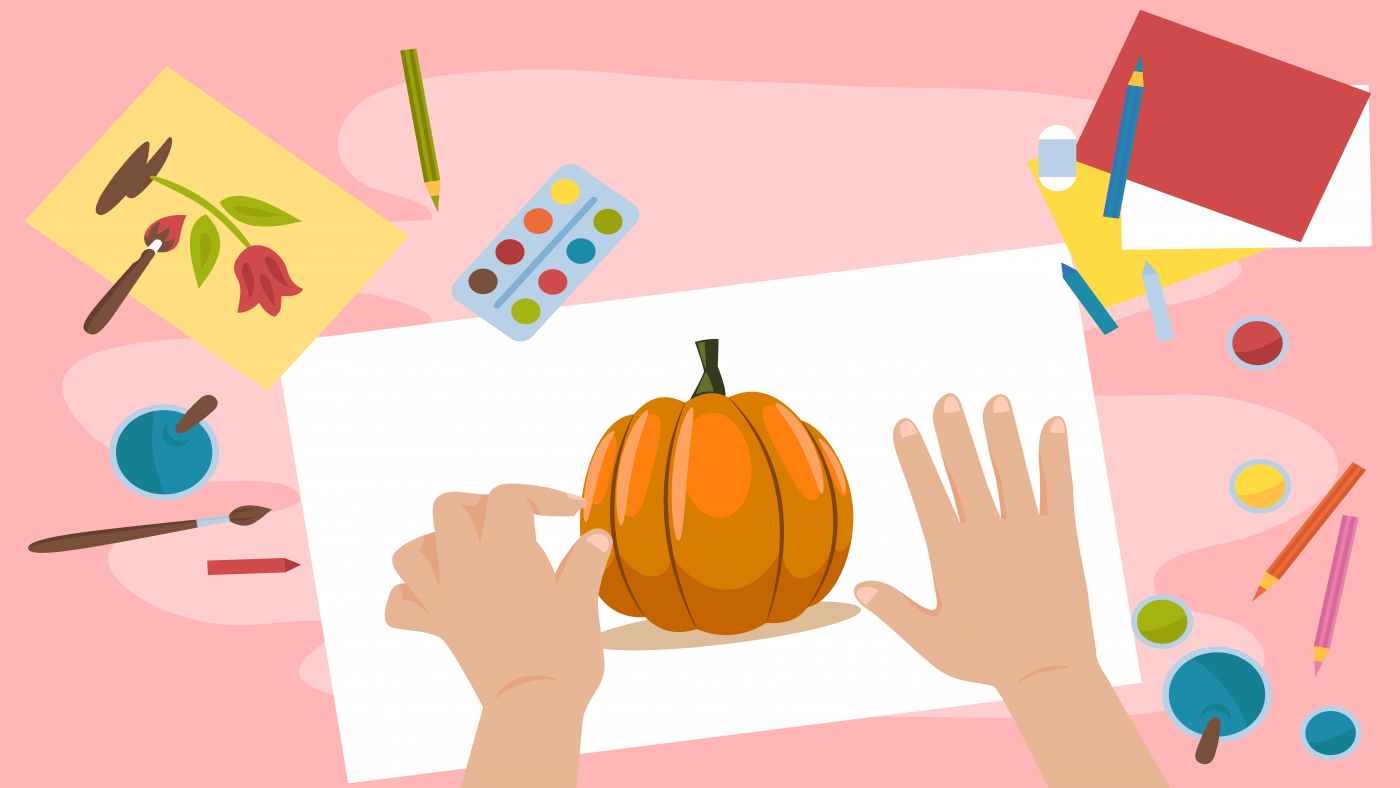
Obsession with pumpkins
The first pumpkin Kusama saw was with her grandfather when she went to pick it, it began speaking to her and it became the size of a man’s head she decided to go home and paint what she saw and she won a prize for it, her first-ever art prize at the age of eleven.
These pumpkins would be a golden thread throughout her career, 80 years later and her largest silver pumpkin sculptures sell for over 500 000 dollars. These hallucinations of pumpkins inspired Kusama and her art so she kept on drawing what she saw and what she felt.

One day she was so angry with her mother she drew a portrait of her mom obliterating into dots self-destructing into little specks.
World War II
During World War II little Kusama was only 13 years old after the attack of pearl harbour Kusama was sent to work in a military factory she had to sew parachutes for the Japanese army, World War II was busy escalating and she could often hear air raid alerts going off and American b-29s flying overhead the factory was blocked off in the darkness to avoid the bombs.
Kusama remembers her adolescence as being closed in darkness. Her childhood was greatly influenced by the events of the war, she started craving personal and creative freedom, in the evenings she painted intricate flowers over and over.
Finally allowed to become an artist
The local newspaper article about her first exhibition reported that she produced more than 70 watercolours a day – this is obsessive – finally her parents agreed that she could study some form of art but it had to be the traditional Japanese way of painting called nihonga to Kusama the style was super boring stiff and tight and she couldn’t do whatever she wanted.
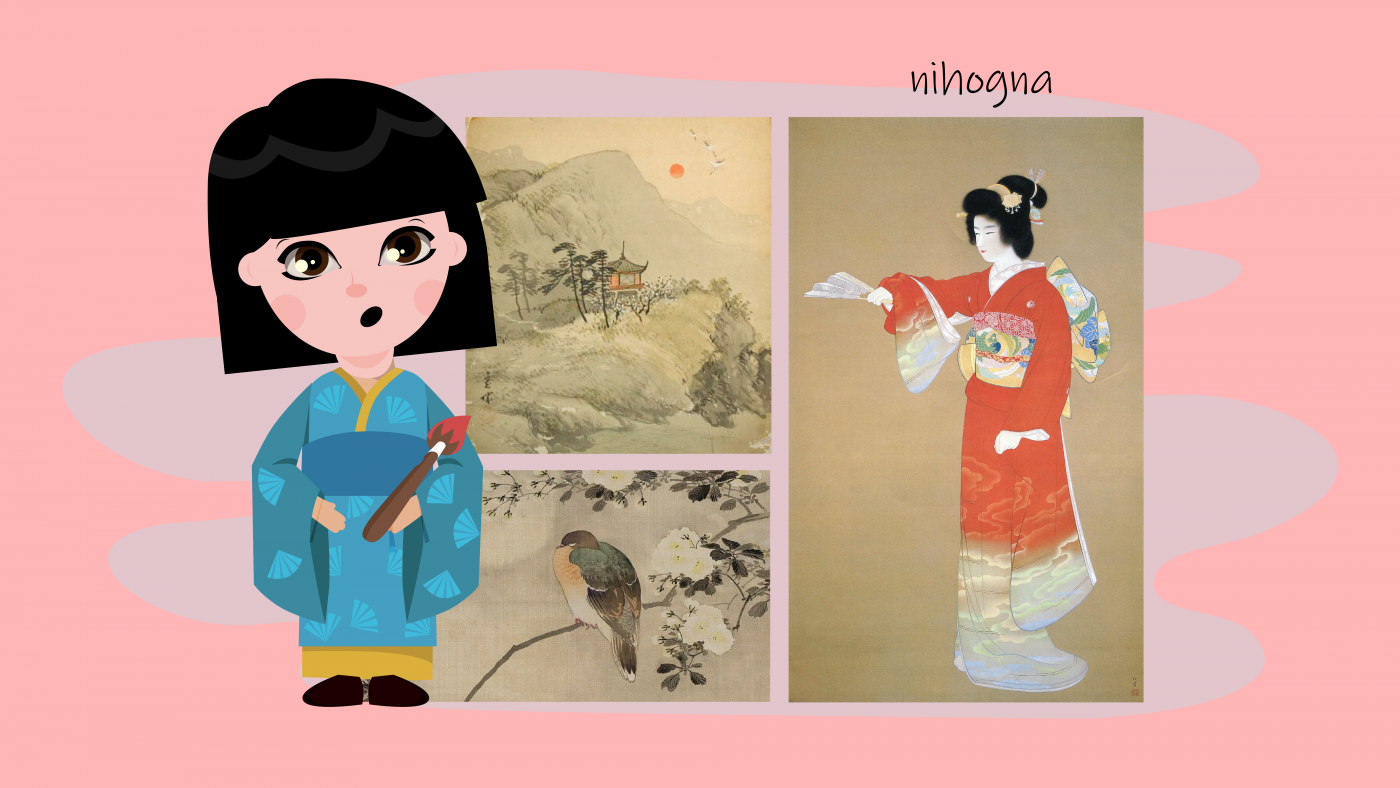
She wanted to create like the American abstract impressionists.
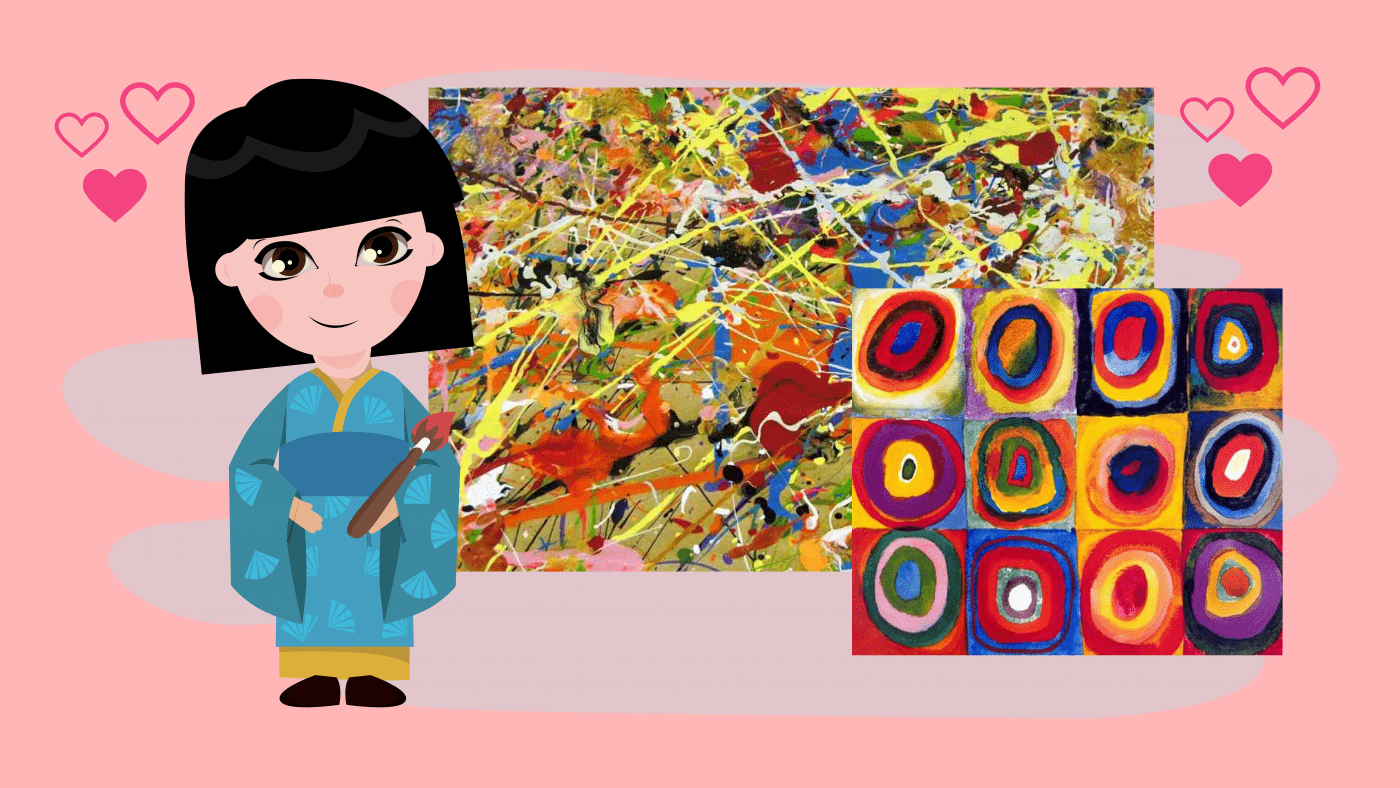
From one female artist to another
One day while browsing a bookshop in her hometown Kusama found a book about the American female artist Georgia O’Keeffe she found O’Keeffe’s address in New Mexico America and decided to write her a letter, she was asking her for advice on how could she become a successful contemporary artist and Georgia O’Keeffe replied.
At first, she was a bit puzzled why would a girl from rural Japan want to become a famous American artist and why would she want a career in contemporary art – but O’Keeffe decided to reply and she convinced Kusama to come to America, she replied warning Kusama saying in this country an artist has a hard time making a living, you will just have to find your way as best as you can.
Off to the big apple
In 1958 Kusama arrived in New York, she was 27 years old she had a few hundred dollars sewn into the lining of a dress and in her suitcase, she had 60 silk kimonos and some drawings, her plan was simple – try to become a successful artist and in the meantime sell the kimonos so she had enough money to live from.
She was so desperate during that time she recalls how she used to scavenge fish heads from the fishmonger’s rubbish that she could boil to make soup just to have something to eat. Kusama really struggled when she came to New York.

Creating Infinity Nets
Finally, Kusama had a breakthrough in her art career. She painted these massive canvases called the infinity nets. She used thick and pastel paints to paint the net pattern over and overlook the negative space between the net’s thread – it looks like dots. These paintings were massive up to 30 feet wide which’s over 9 meters long these infinity nets as she called them were taken directly from her hallucinations.
Understanding Kusama’s hallucinations
Now I want to take a moment and just explain these hallucinations a little bit better to you, have you guys ever stared at a crazy dotty pattern for a long time and when you close your eyes you can still see that pattern? Have you ever laid outside in the sun, closed your eyes and then the sunlight starts making these dots in your eyelids almost red dots floating around? – That’s a little bit like Kusama’s hallucinations.

Kusama tells of an incident she was sitting in her kitchen staring at a tablecloth filled with little red flowers she stared at it for a long time and when she closed her eyes and looked up she could see this pattern on the ceiling, on her body, everywhere – and it started feeling like it was consuming her, like her body was dissolving into these tiny tiny dots.
This vision really really scared Kusama, she started fearing for her life and ran up the stairs the whole world started falling apart and she fell down the stairs spraining her ankle.
Understanding Kusama’s Infinity Mirrors
Another aspect of a work I would like to explain comes from a lift, have you ever entered an elevator with mirrors on both sides your reflection starts reflecting itself repeating your image over and over until infinity? Well, this inspired Kusama. She felt this was a strong visual way to show people how patterns repeat in her hallucinations. She started creating infinity rooms and in these rooms she used mirrors to repeat dots of light over and over.

Understanding Kusama’s soft sculptures
Another aspect of Kusama’s work I’d like to discuss with you and explain is her development of soft sculpture, all the childhood trauma of spying on her father’s affairs really gave her her disgust and contempt for the male body, Kusama transformed all this anxiety towards the male body into soft sculptures developing these tentacles that she sewed out of material and stuffed with inners that almost feels like it’s going to grab you.
Looking at these objects really gives us a sense of unease and it really evokes in us that feeling of anxiety that Kusama must have experienced.

Now that you understand a little bit more about Kusama’s hallucinations let’s get back to the story.
Pop Art Movement
The 1960s art scene in New York was a really fun time. It is the time of Pop Art, popular art and known for artists such as Andy Warhol, Peter Blake, Roy Lichtenstein, Robert Rauschenberg and Yoko Ono. It’s usually fun bright and playful.
Now when we look back at the 1960s and read about pop art we don’t really read about Kusama why is that it almost seems like she was written out of the history a lot of Kusama’s original ideas were appropriated by the men around her which they then passed off as their own ideas – Oldenburg seems to have adopted Kusama’s soft sculptures and Andy Warhol her repetitive wall paper prints.

Many male artists copied Kusama’s creativity which made the men famous but not Kusama therefore Kusama couldn’t really live off her art, she wasn’t financially paid what was due to her.
Desperate and desolate
This really really upset Kusama and she was hospitalized for overworking trying to just work harder and harder to become known as an artist and O’Keeffe convinced their own art dealer to purchase several of Kusama’s artworks just so Kusama could survive with a little bit of money, this frustration became so extreme that Kusama attempted suicide.

Kusama also did performance pieces; she dressed up in a Japanese national costume and she walked through the rough neighbourhoods of New York capturing everything with photos she was trying to depict herself as an outsider in New York.
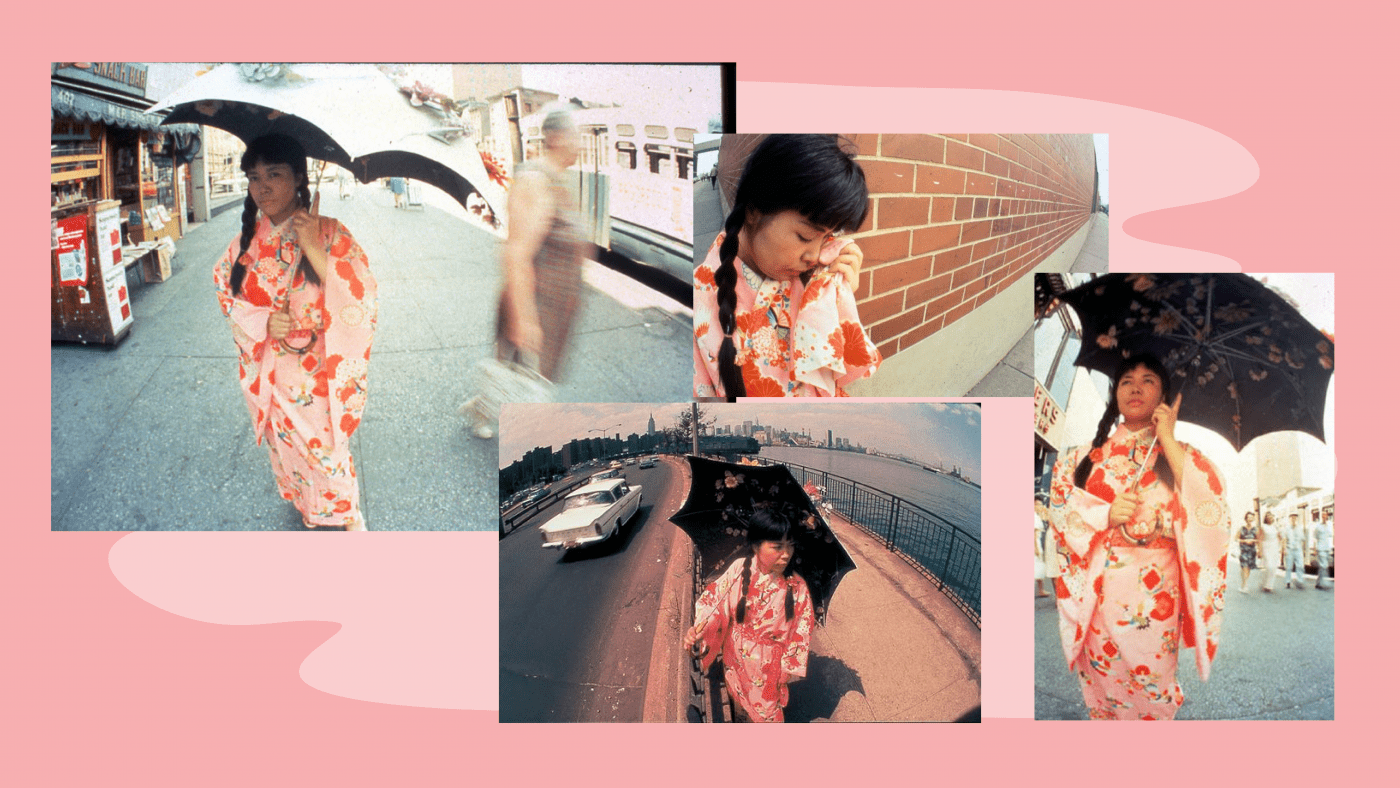
Narcissism for sale
In 1966 at the 33rd Venice biennial Kusama did something crazy she kind of hijacked the entire occasion and set up a narcissist garden, now for those of you that don’t know what narcissism is it’s actually based on a story in Greek mythology there was this god called Narcissus.
He was so beautiful that he fell in love with his own reflection in a river, he was so obsessed with himself that he eventually drowned and died so Kusama set up a thousand five hundred highly reflective shiny balls in a lake just outside the Venice biennial when a person picked this up and looked at it their face would infinitely multiply.
She sold the balls for two dollars each and put up a sign saying your narcissism for sale, this artwork plays with the idea of the obsession we have with ourselves and our image and in a way it was foreshadowing the crazy selfie culture that was to come the biennial authorities stopped the performance objecting saying to Kusama ‘you cannot sell art like it is hot dogs or ice cream cones’.

A Flower child queen
1967 in America brought a social phenomenon known as the summer of love. It was hippie culture, people were anti-government, anti-establishment all they wanted was peace and love and to live in harmony and these massive parties happened all over America celebrating this culture.
Kusama positioned herself as a high priestess of flower power and she started painting the partygoers in polka dots, later she expanded this into some performance art staging a protest opposite the New York stock exchange and on the steps of the statue of liberty against Richard Nixon and the Vietnam war.

Returning to Japan
When this era came to an end Kusama became somewhat of an outcast in New York she decided to return to Japan, back in her home country and surrounded by her culture her hallucinations and panic attacks over adolescence returned with a full force she was hospitalized several times she began manically writing visceral surrealistic novels short stories poetry and autobiography.
In march 1977 Kusama admitted herself to a psychiatric hospital, for a lot of people admitting themselves to a hospital might have seemed like the end of the road, the end of their hopes and their dreams but for Kusama, it was a new start – being in hospital really helped her to manage her hallucinations, her mania and her anxiety. It helped her to no longer be concerned with things of survival like food and washing, to have more time to focus on her creativity.
The hospital offered art therapy courses and Kusama immediately signed up and never left Kusama is often quoted as saying “if it were not for art I would have killed myself a long time ago” Kusama’s painting style started changing into high coloured massive acrylic canvases and amped up on scale and pattern when Kusama left New York.
“If it were not for art I would have killed myself a long time ago.”
Yayoi Kusama

A forgotten artist that was rediscovered
She was practically a forgotten artist until much much later in the 1990s when a number of retrospective exhibitions revived international interest in this artist. We have to wonder why such a talented artist like Kusama seemed to almost disappear off the face of the earth and then catapult into world fame and popular demand after the 1990s.
Well the answer to that question lies in the age of the selfie and instagramable nature of an artwork – we became more and more obsessed with taking images of ourselves and Kusama’s artwork just makes for the most amazing selfies.

Creating an infinity of dots
She creates this captivating environment of dots that she creates with little led lights reflecting into mirrors the pinpricks of the light in the darkroom reflect endlessly in the mirrors making you feel like you are in an apparently endless space, the dots around you engulf you it’s very hard to tell where does the room end and where does the room begin it feels like infinity.
Even though the smartphone-friendly nature of her work is clearly part of the massive attraction it does lead to a deeper understanding of Kusama’s life. Most visitors are shocked to realize that she lives in a psychiatric hospital, once they hear of Kusama’s struggles with their mental health they feel inspired – some can identify with that and they feel encouraged to face their own dramas.

She also makes other playful rooms like once she filled an entire room with pumpkins and the pumpkins have become a very strong symbol in Kusama’s work almost becoming an alter ego to her self-portrait of herself as a young child. In her ninth decade Kusama has continued to work as an artist she has remained innovative and a multi-disciplinary artist experimenting with fashion, major large canvases, sculpture installations, performances and lately even technology design.
Just to give you an idea of the demand of Kusama’s work her pumpkin room called ‘all the eternal love that I have’ was filled with more than 600 pumpkins it was the museum’s most popular attraction ever Kusama’s infinity mirror exhibitions became a sensation amongst art critics as well as social media museum visitors shared more than 34 000 images of the exhibition on their Instagram accounts and social media posts using the hashtag infinite Kusama garnered more than 350 million impressions.
Kusama as a fashion icon and trendsetter
Way back when Kusama was still living in New York she established Kusama fashion company and she began selling avant-garde fashion in the Kusama corner at Bloomingdale’s. Today she has got quite a massive fashion empire and she has worked with famous brands such as Louis Vuitton and Lacombe.
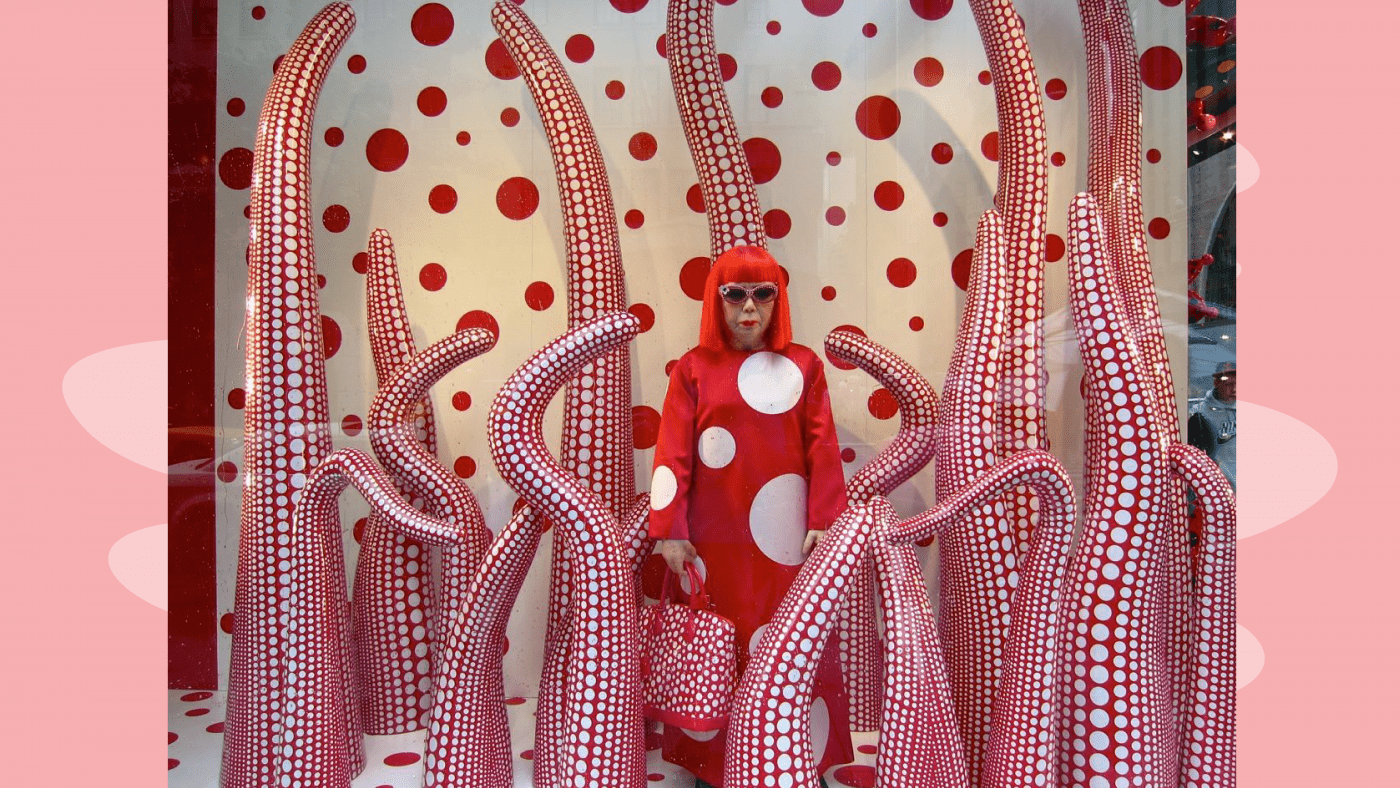
A Japanese mobile communication giant has also commissioned Kusama to design a cell phone. She designed a dog shaped phone called ‘my doggy ring ring a handbag for space travel’ which was a pink dotted phone in the accompanying dog-shaped holder.

Lacome and Kusama Collaboration
Lacombe has also partnered with Kusama to design a sixth limited-edition lip gloss range in that same year Kusama also worked with Marc Jacobs on a new line for Louis Vuitton products. To date, Kusama has also completed several major outdoor sculptural commissions mostly in the form of brightly viewed monstrous plants and flowers for public and private institutions.
In the past five years more than five million people have visited Kusama exhibitions around the world they queue for hours to see a 91-year-old Japanese artist who for the past 41 years has lived voluntarily in a psychiatric hospital.
As the number of visitors increases to her exhibitions the number of time visitors can spend in our infinity rooms goes down, a gallery in New York restricted time slots to 45 seconds while a museum in Washington DC only allows people 30 seconds with Kusama’s artwork.

International Acclaimed Artist
Since then Kusama has opened her own five-storey gallery in Tokyo. The board museum in Los Angeles recently sold 90 000 25-dollar tickets in one afternoon when they opened their Kusama exhibition.
Kusama is an award-winning artist, she has won so many awards but just to highlight a few she is the winner of the national lifetime achievement award of the order of the rising sun. Kusama also became the first Japanese woman to receive the premium imperial – one of Japan’s highest honours for internationally recognized artists. In 2014 Kusama was ranked as the most popular artist of the year after a record-breaking number of visitors flooded her Latin American tour. ‘Infinite obsession’ received more than 8 500 visitors each day in Buenos Aires. In the world’s art market Kusama’s art has performed really strong at art auctions.

Kusama became the most expensive living female artist at auction when one of her former signatory infinity net series sold for 7.1 million dollars at a 2014 Christine auction. Kusama is also often referenced in popular culture, many songs have been written about her and artists like Yoko Ono often cites Kusama as her inspiration. Many books have also been written about Kusama and documentaries have been made. When asked about her worldwide fame Kusama is quite humble, she said that
“Long ago I decided that all I could do was express my thoughts through my art and that I would continue to do so until the day I died even if no one ever saw my work, today I will never forget that my artworks have moved millions of people all around the world”
Yayoi Kusama
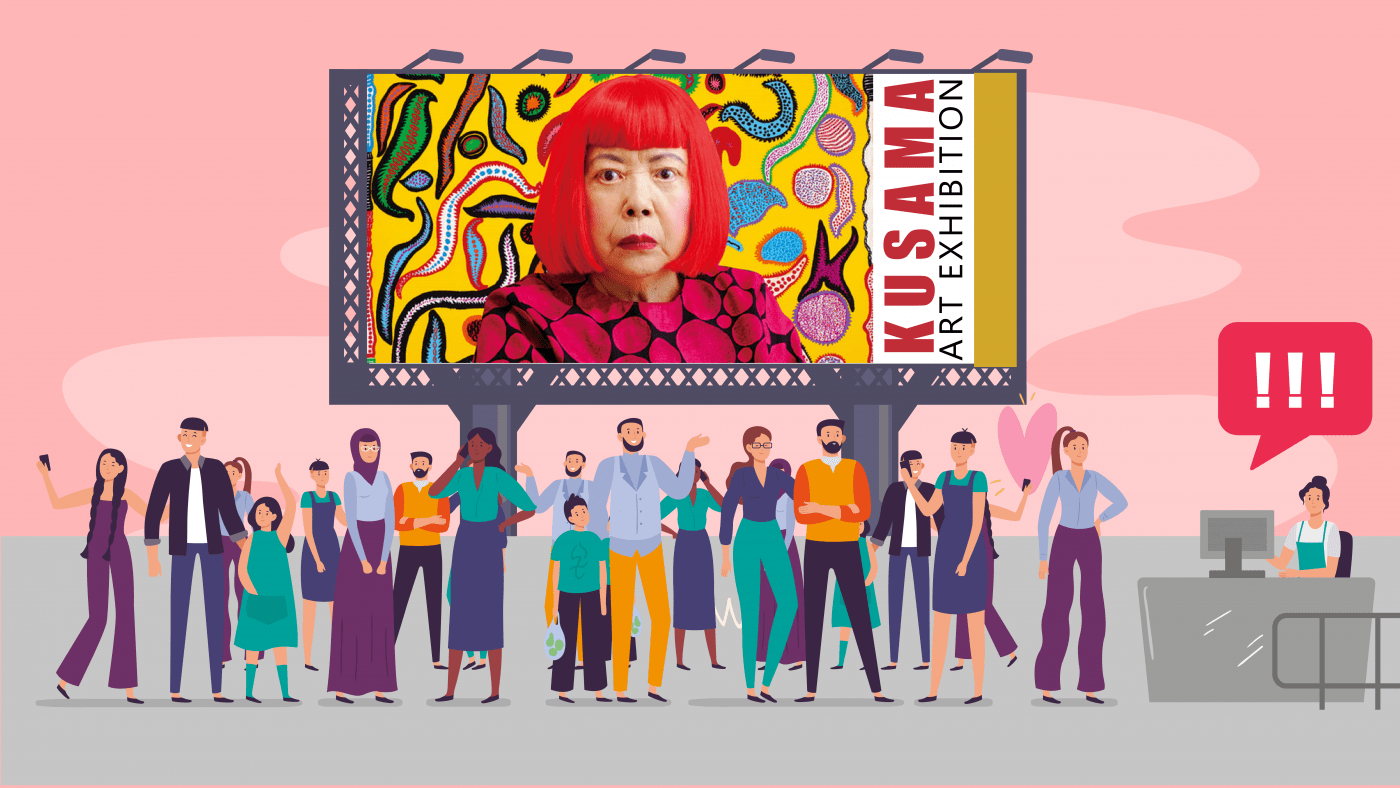
Kusama has achieved the rare double of serious critical attention and immense popularity. As a child she said she always wanted Kusama to be everywhere – the internet with social media has granted Kusama that wish in a way she could not have imagined – what an incredible journey for a little girl sitting frightened amongst flowers in anxiety and depression as a little girl.
Characteristics of Yayoi Kusama’s Artwork
Now let’s look at the characteristics of Kusama’s artworks. We need to ask ourselves what did she paint, where did she paint it, how did she paint it, and most importantly why.
What was Kusama’s subject matter?
Kusama painted pumpkins, flowers and dots all from her childhood hallucinations. She is also known for major soft sculptures which depict the anxiety her father’s affairs created in her life.
Where did Kusama create?
Mostly in New York and Japan. To this day Kusama sleeps in the psychiatric hospital each night and she works in her art studio across the road six days a week. She still makes her own clothes and she has very little interest in the wealth that has come in her late life. She has a small team of assistants in a studio and gallerists who look after her interest in New York, Tokyo and London.
What was Kusama’s art style?
Kusama is a multi-disciplinary artist but whatever she creates she is known to cover it in dots. She usually works in her studio sitting at a table with a massive canvas flat in front of her not on an easel she does no planning and she just starts creating from her hallucinations with different patterns pouring out onto the canvas and she often says the canvas cannot keep up with her she says
“I have been painting and drawing and writing from morning until night since I was a child when I arrive at my studio in the morning I put on my work clothes and I start to paint straight away I work right up until dinner time and I never take a break I’m an insomniac so when I cannot sleep I grab my sketchbook and I draw”.
Yayoi Kusama
Why does Kusama create art?
Now let’s discuss the most important of all – the why. What is the purpose of Kusama’s art and what is the meaning behind all these dots? If we think about it on a deeper level we are surrounded by dots: the sun is a dot, the moon is a dot, even the earth the planet that we live on is a dot. What is remarkable to me is that the country that Kusama is from Japan, even the flag, is a dot. Everything around us our entire universe is made out of dots – molecules – atoms – dots that are vibrating dots that are infinite. We are all just a collection of dots.
Here is a quote from Kusama about the meaning of her art
“Our earth is only one polka dot among a million stars in the cosmos polka dots are a way to infinity when we obliterate nature and our bodies with polka dots we become a part of the unity of our environment”
Yayoi Kusama
And that’s the story of the wonderful artist Yayoi Kusama! I’m artist Lillian Gray and I hope you enjoyed this story. I’m a lover of art history and I hope that you guys are inspired.
Let’s social, meet me on Instagram or Facebook and remember to subscribe and like our channel!
BUY OUR YAYOI KUSAMA WORKSHEETS
Worksheet pack that includes notes and fun activities. Ideal for art students and history students to learn more about the artist Yayoi Kusama

